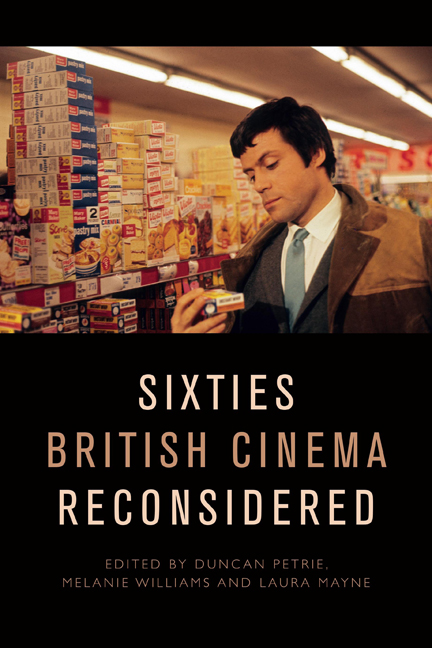Book contents
- Frontmatter
- Contents
- List of Figures and Tables
- Notes on the Contributors
- Introduction
- PART ONE STARS AND STARDOM
- 1 Male Stardom in 1960s British Cinema
- 2 ‘Rebel Rebel’?: Oliver Reed in the 1960s
- 3 Carol White: The Bardot of Battersea
- 4 ‘The Old Wave at Work’: The Transatlantic Stardom of the British Character Actress in the 1960s
- PART TWO CREATIVE COLLABORATIONS
- 5 Woodery-pokery: Charles Wood’s Sixties Screenwriting
- 6 ‘Beyond Naturalism’: Jocelyn Herbert, If . . . (1968) and Design for Performance in 1960s British Cinema
- 7 Kes: From Page to Screen
- 8 ‘I’d like to remember you as you are – as just a grumpy old man’: Joseph Losey and the Making of Figures in a Landscape (1970)
- PART THREE STYLE AND GENRE
- 9 ‘Wholesome rough stuff’: Hammer Films and the ‘A’ and ‘U’ Certificate, 1959–65
- 10 Widescreen Pyrotechnics: Shot Composition and Staging in the Cold War Films of Joseph Losey and Sidney J. Furie
- 11 The Rise and Fall of the Colourful Corporate Fantasy in 1960s British Cinema
- 12 Witchfinders and Sorcerers: Sorcery and Counterculture in the Work of Michael Reeves
- PART FOUR CULTURAL TRANSFORMATIONS
- 13 ‘An Impulse of Anger, Instantly Regretted’: Rebellion and Reaction in the Early-1960s Naval Film
- 14 Narratives of Race and Identity in Sixties British Cinema
- 15 Panic at the Disco: Brainwashing, Alienation and the Discotheque in Swinging London Films
- Index
10 - Widescreen Pyrotechnics: Shot Composition and Staging in the Cold War Films of Joseph Losey and Sidney J. Furie
Published online by Cambridge University Press: 22 September 2020
- Frontmatter
- Contents
- List of Figures and Tables
- Notes on the Contributors
- Introduction
- PART ONE STARS AND STARDOM
- 1 Male Stardom in 1960s British Cinema
- 2 ‘Rebel Rebel’?: Oliver Reed in the 1960s
- 3 Carol White: The Bardot of Battersea
- 4 ‘The Old Wave at Work’: The Transatlantic Stardom of the British Character Actress in the 1960s
- PART TWO CREATIVE COLLABORATIONS
- 5 Woodery-pokery: Charles Wood’s Sixties Screenwriting
- 6 ‘Beyond Naturalism’: Jocelyn Herbert, If . . . (1968) and Design for Performance in 1960s British Cinema
- 7 Kes: From Page to Screen
- 8 ‘I’d like to remember you as you are – as just a grumpy old man’: Joseph Losey and the Making of Figures in a Landscape (1970)
- PART THREE STYLE AND GENRE
- 9 ‘Wholesome rough stuff’: Hammer Films and the ‘A’ and ‘U’ Certificate, 1959–65
- 10 Widescreen Pyrotechnics: Shot Composition and Staging in the Cold War Films of Joseph Losey and Sidney J. Furie
- 11 The Rise and Fall of the Colourful Corporate Fantasy in 1960s British Cinema
- 12 Witchfinders and Sorcerers: Sorcery and Counterculture in the Work of Michael Reeves
- PART FOUR CULTURAL TRANSFORMATIONS
- 13 ‘An Impulse of Anger, Instantly Regretted’: Rebellion and Reaction in the Early-1960s Naval Film
- 14 Narratives of Race and Identity in Sixties British Cinema
- 15 Panic at the Disco: Brainwashing, Alienation and the Discotheque in Swinging London Films
- Index
Summary
Widescreen film technology was gradually adopted in Britain after 1953, the year which saw the introduction of CinemaScope by Twentieth Century-Fox. In a strategy that would incite the Free Cinema movement to state that ‘size is irrelevant’ to British documentary film, global marketing frequently emphasised the visual and budgetary scale of widescreen films. By the end of the 1960s, a number of significant widescreen epics such as The Guns of Navarone (1961), Lawrence of Arabia (1962), Zulu (1964), Those Magnificent Men in their Flying Machines (1965) and 2001: A Space Odyssey (1968) had been made in Britain. Unfolding over more than two hours while showcasing widescreen colour cinematography and large-scale production design, such titles fit comfortably within or adjacent to the Hollywood tradition of film epics and spectaculars outlined by Steve Neale and Sheldon Hall. Lavish spectaculars have helped to ensure that British cinema features in historical surveys of the widescreen era. But despite providing one of its most significant formal trends, these types of film do not capture the diverse widescreen output of the 1960s. Indeed, with the increasingly extravagant James Bond series aside, of which Thunderball (1965) would be the first entry in Panavision, major widescreen productions such as Lawrence of Arabia were marketed in prestigious terms largely because of their rare occurrence.
There have been few attempts to broaden the analysis of authorship, genre and style in British widescreen films of the 1960s since Charles Barr's 1963 essay on CinemaScope, and Duncan Petrie's The British Cinematographer, published in 1996. In response, the widescreen films examined in this chapter do not align with the familiar canon of film epics outlined above, though they contain stylistic experiments that might be considered visually spectacular in other, more challenging ways. By the 1960s, European widescreen films spanning a range of genres and budgets became more common thanks to commercially ambitious studios including Hammer Films in Britain, and the diffusion of affordable widescreen formats such as Techniscope in Italy and Dyaliscope in France. In this expanded context, film directors were allowed to trial idiosyncratic widescreen compositions and staging with the help of relatively small crews, modifying their approach to camera movement, montage, and other storytelling devices.
- Type
- Chapter
- Information
- Sixties British Cinema Reconsidered , pp. 165 - 178Publisher: Edinburgh University PressPrint publication year: 2020

